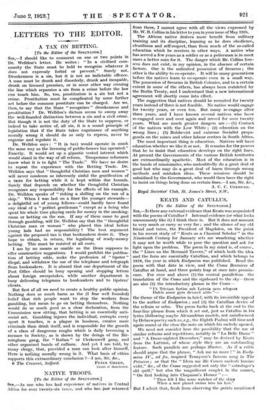KEATS AND CATULLUS.
[To the Editor of the SPECTATOR.] Sin,—Is there any external evidence that Keats was acquainted with the poems of Catullus-? Internal evidence (or what looks uncommonly like it) I think there is. But it does not amount to very much or carry us very far ; and the silence of my old friend and tutor, the President of Magdalen, on the point in his recent study of " Keats as a Classical Scholar " in the Nineteenth Century for January sets me wondering whether it may not be worth while to pose the question and ask for light upon the problem. The poem in my mind is, of course, the " Lines on the Mermaid Tavern," of which both the idea and the form are essentially Catullian, and which belongs to 1818, the year in which Endymion was published. Read the poem with that date in view, and the Coma Bercnices of Catullus at hand, and three points leap at once into promin- ence. For over and above (1) the central parallelism—the translation of the Coma and the signboard to the sky—there are also (2) the introductory phrase in the Coma-
" TR Triviam furtim sub Latmia saxes rclegans Dulcis amor gyro devocet !Grit) "- the theme of the Endymion in brief, with its irresistible appeal to the author of Endymion ; and (3) the Catullian device of the refrain or echo. The poem harks back at the end to the four-line phrase from which it set out, just as Catullus in his lyrics (following maybe Alexandrian models, not uninfluenced by Hebrew poetry such as, e.g., the Eighth Psalm) will time and again sound at the close the note on which his melody opened.
We need not consider here the possibility that the use of similar refrains and repetitions, notably in " La Belle Dame " and " A Drear-nighted December," may be derived by Keats from the Latinist, of whose style they are an outstanding feature. Such parallels arc perhaps illusive. As if a critic should argue that the phrase, " Ask me no more ! " in Endy- mion IV., ad fin, inspired Tennyson's famous song in The Princess ; or that the " Idem me ille Conon caclesti luminc vidit," &c., of the Coma suggested not only the " astrologer's old quill," but also the magnificent couplet in the sonnet, " On first looking into Chapman's Homer " :- " Then felt I like some watcher of the skies When a new planet swims into his ken."
But I admit that, fresh from observing the points mentioned above, I did turn to Lord Houghton's Heats with a lively expectation of learning that, as the " Homeric " sonnet was found by Clarke on his breakfast-table the morning after he and Keats had " sat up till daylight " revelling in Homer, so this poem had been the reward of Benjamin Bailey for introducing Keats to Catullus in the course of those weeks the two friends spent together at Oxford while Endymion was still " on the stocks." Is it credible that such an enthu- siast as Bailey for " the old poets "—Greek and Latin— could either have been a stranger himself to the Coma Berenices or have failed at one time or another to make known to the poet of Endymion this delightful extravaganza, prefaced as it is by one of the very few references that Latin poetry offers to the story of " the Latmian " ? But if Bailey did his devoir, why, ah why, did not Keats, who " before he left Enfield had translated on paper the whole of the Aeneid,"t pursue the study of the older poet further ? Lyrics of Catullus, " Englished " by the author of " the Ode " would indeed have been a eribet is Ad, a possession for all time.—I am, Sir, &e., D. A. S.











































 Previous page
Previous page